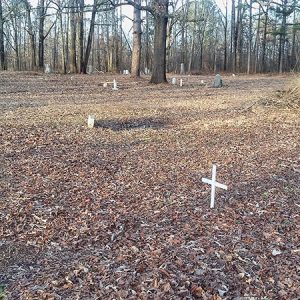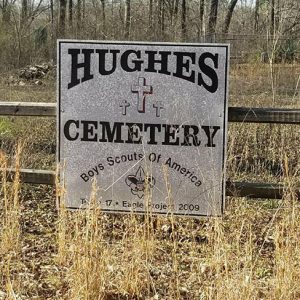calsfoundation@cals.org
Green B. Hughes (1800–1858)
Green B. Hughes was an influential figure in early Arkansas. He served as the first postmaster at what is now Benton in Saline County in 1836. Later, Hughes served as county clerk and county judge before being elected to the Arkansas House of Representatives. He also served as a railroad commissioner and chairman of the Saline County Democratic Party. Hughes died in the summer of 1858, reportedly leaving behind an estate worth a considerable amount.
Green B. Hughes was born in Tyrrell County, North Carolina, in 1800 to parents of Welsh descent. He moved to Hot Springs (Garland County) in 1818, when Arkansas was still a territory. He married Louisa West, the sister of Claiborne West, one of the signers of the 1836 Texas Declaration of Independence (the formal declaration of independence of the Republic of Texas from Mexico in the Texas Revolution). Hughes and his wife eventually had two sons, George West Hughes and John Lockert Hughes, and one daughter, Catherine Hughes Steele.
In 1825, Hughes opened a store in Greenville (Clark County), operating it until 1828, when he moved to Camden (Ouachita County). Hughes was commissioned sheriff of Hot Spring County on November 21, 1829. The next year, Hughes was living in Union County. On August 9, 1830, Hughes took over as county judge in Union County when Jonath Black Sr. resigned. Hughes became a magistrate (justice of the peace) there on November 5, 1831.
Hughes was listed as justice of the peace for Pulaski County (in an area that later became part of Saline County) on October 27, 1835. Due to flooding, many settlers living in Saline Crossing (Saline County) moved farther inland, including the Hughes family. In November 1835, Saline County was created by the Arkansas General Assembly. Benton competed with the village of Saline Crossing and Collegeville (Saline County) for the county seat. Benton won the battle, and in 1836, Hughes became postmaster at Benton.
Hughes played a major role in the formation of the city of Benton. On June 15, 1836, the same day Arkansas became a state, newspaperman William E. Woodruff and his wife, Jane Eliza Woodruff, executed a deed naming Green B. Hughes and Rezin Davis trustees in charge of 120 acres of land. On June 10–11, 1836, 114 lots in what is now Benton had been sold for an average of $30 each by Hughes and Woodruff. Officers were elected, and Benton was founded on June 15, the same day Woodruff’s deed was executed.
From 1836 to 1838, Hughes served as county clerk. However, Hughes’s name appears as clerk in the Arkansas Banner as late as 1846. On July 4, 1837, Hughes and Davis, along with a group of elected commissioners, laid out what became Benton. The original plat was put on display at the Gann Museum and shows that the town was planned as a grid around the Saline County Courthouse with streets named for the Sevier, Conway, and Johnson families who dominated Arkansas politics at the time as “The Family.”
On July 3, 1839, Hughes was appointed commissioner of public buildings for Saline County. He served as county judge from 1844 to 1846. That year, he ran successfully against Ezra M. Owen of Collegeville for a seat in the Arkansas House of Representatives. Hughes served in the House from 1846 to 1848. In 1850, Hughes owned nine slaves.
On March 3, 1851, the Iron Mountain railroad was chartered by the Missouri legislature; it ran from St. Louis, Missouri, to Austin, Texas. Hughes was a commissioner of the “central” railroad by 1852. In that capacity, Hughes worked to sell stock in the railroad. In 1853, he was listed as chairman of the Saline County Democratic Party. Presumably, Hughes remained with the railroad until his death.
Green Hughes died on June 24, 1858, and is buried in the Hughes family cemetery at Benton.
Hughes’s will was executed the day of his death and filed for probate five days later; his executors were his two sons. The sureties on the bond were William Woodruff, George C. Watkins, Sterling H. Tucker, and Alfred R. Hockersmith. Per Hughes’s will, his executors were required to make bond in the substantial sum of $40,000. Reportedly, Hughes’s estate consisted of 3,000 acres of land split among Hot Spring, Saline, and Prairie counties. There were eleven city blocks in Benton, including the land where the courthouse sits in the twenty-first century.
At some point, Hughes Cemetery became a pauper’s graveyard and was largely abandoned by the City of Benton. Many markers have been either stolen (including that of Green Hughes and Louisa West Hughes) or vandalized. In 2009, the local chapter of the Boy Scouts of America cleaned the area and put up a sign and an iron gate. Nearly a decade later, the area was grown over again, but another clean-up project restored the cemetery in 2018.
For additional information:
“Died.” Arkansas Gazette, April 21, 1860, p. 3.
Benton Courier Centennial Number, March 25, 1937.
Biographical and Historical Memoirs of Central Arkansas. Chicago: Goodspeed Publishing Co., 1889.
Clarence Edwin Carter, ed. Territorial Papers of the United States. Vol 29: The Territory of Arkansas 1819–1825. Washington DC: Government Printing Office, 1953.
“Democratic Meeting in Saline.” Arkansas Gazette, April 29, 1853, p. 3.
“Hughes Family Has Ties to Local History.” Benton Courier, September 22, 1982, p. 8.
Cody Lynn Berry
Benton, Arkansas
 Louisiana Purchase through Early Statehood, 1803 through 1860
Louisiana Purchase through Early Statehood, 1803 through 1860 Politics and Government
Politics and Government Hughes Cemetery
Hughes Cemetery  Hughes Cemetery
Hughes Cemetery 



Comments
No comments on this entry yet.